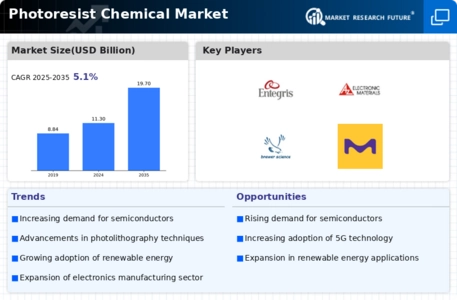Rising Demand for Semiconductors
The Photoresist Chemical Market is experiencing a notable surge in demand driven by the increasing need for semiconductors across various sectors. As industries such as automotive, telecommunications, and consumer electronics expand, the requirement for advanced semiconductor devices grows. In 2025, the semiconductor market is projected to reach approximately 600 billion USD, which directly influences the demand for photoresist chemicals used in photolithography processes. This trend indicates a robust growth trajectory for the photoresist chemical sector, as manufacturers seek to enhance the performance and efficiency of semiconductor devices. The ongoing miniaturization of electronic components further necessitates the use of high-quality photoresists, thereby propelling the Photoresist Chemical Market forward.
Emerging Applications in Electronics
The Photoresist Chemical Market is witnessing growth due to emerging applications in various electronic devices, including flexible electronics and wearables. As consumer preferences shift towards innovative and multifunctional devices, manufacturers are increasingly utilizing photoresist chemicals to create intricate patterns on flexible substrates. The flexible electronics market is expected to reach approximately 50 billion USD by 2025, indicating a significant opportunity for photoresist producers to develop specialized formulations that meet the unique requirements of this sector. This trend highlights the adaptability of the Photoresist Chemical Market in responding to evolving technological demands and consumer preferences.
Growth in Renewable Energy Technologies
The Photoresist Chemical Market is also benefiting from the expansion of renewable energy technologies, particularly in the production of solar cells. The increasing adoption of photovoltaic systems is driving the demand for photoresist chemicals used in the fabrication of solar panels. In 2025, The Photoresist Chemical is projected to reach around 300 billion USD, which correlates with the rising need for efficient photoresist materials that can enhance the performance of solar cells. This trend suggests a promising avenue for photoresist manufacturers to diversify their product offerings and cater to the renewable energy sector, thereby contributing to the overall growth of the Photoresist Chemical Market.
Advancements in Photolithography Techniques
Innovations in photolithography techniques are significantly impacting the Photoresist Chemical Market. The introduction of extreme ultraviolet (EUV) lithography is revolutionizing the manufacturing of integrated circuits, allowing for smaller feature sizes and improved resolution. This advancement is expected to drive the demand for specialized photoresist materials that can withstand the rigorous requirements of EUV processes. As of 2025, the market for EUV lithography equipment is anticipated to exceed 10 billion USD, indicating a substantial opportunity for photoresist manufacturers to develop tailored solutions. The evolution of these techniques not only enhances the efficiency of semiconductor production but also fosters competition among manufacturers, thereby stimulating growth within the Photoresist Chemical Market.
Regulatory Support for Advanced Manufacturing
Regulatory frameworks promoting advanced manufacturing practices are positively influencing the Photoresist Chemical Market. Governments are increasingly investing in initiatives aimed at enhancing manufacturing capabilities, particularly in the semiconductor and electronics sectors. These initiatives often include funding for research and development, which encourages innovation in photoresist formulations and applications. As of 2025, various countries are expected to allocate substantial budgets towards enhancing their semiconductor manufacturing capabilities, which will likely boost the demand for high-performance photoresist chemicals. This supportive regulatory environment is anticipated to foster growth and competitiveness within the Photoresist Chemical Market.

















Leave a Comment